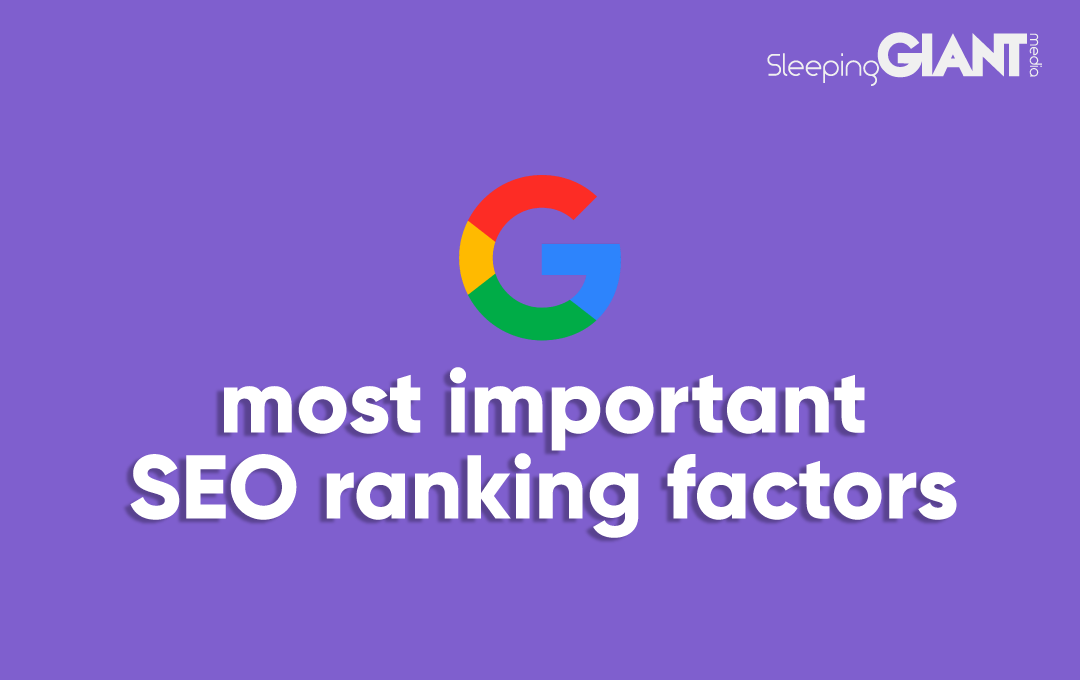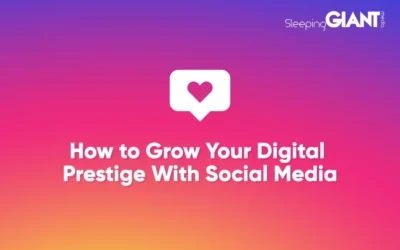
Exploring the most controllable elements of search engine optimisation.
Ever wondered how Google decides which website to place in top position on the search engine results page?
Google, like most search engines, has multiple factors involved in this process, determining how to position the millions and millions of websites that pass through its digital roots every single day.
Making sure you tick Google’s boxes for these factors is called search engine optimisation, or SEO, and is a really important task for any website owner out there.
It’s all about helping you to be seen and found online, because being on that first page of search results is key – we’ve only ever ventured to page 4 when we’ve been desperate for citations in school essays, right?
There are some consistent in what Google considers a ‘ranking factor’, and many things that Google would never reveal the truth on (because where’s the fun in that?).
As an SEO agency in the UK, we’re familiar with many of the things that make Google tick, and we’re breaking down ten such elements today to help you boost your online rankings.
But hey, if you ever want help, we’ve got some bespoke SEO services for you, or some packaged SEO solutions too…
What factors does Google consider important when ranking websites?
1. Mobile Usability
The growth in mobile device usage has soared through the roof in recent years, and we can’t play dumb to it – Google literally won’t let us…
Because of this, Google is leading in the mobile-first revolution.
The ease and instantaneousness of mobile devices bring so much value to users, and that’s what Google is a Giant advocate for.
Therefore, mobile usability is super important. We want to make sure our websites are optimised to be mobile-first, so that navigation for these users is easy peasy lemon squeezy.
Remember, the customer comes first!
The things you need to consider then, to me mobile friendly, are things like:
- How does it look on a mobile? Do certain images crop, or animations not work?
- Do all the buttons actually work?
- Is the text legible? Can you read it on a small screen?
- Does the content fit on the screen?
- Is there too much to scroll through?
Make the amends you need accordingly to boat your rankings, checking Google’s own mobile-friendly test to see how you’re doing.
2. Keyword Targeting
The act of keyword targeting allows you to show up within Google search results for specific things people search for!
For example, if you want to show up in front of someone searching for a “local shoe shop” you will need to target that keyword within your content.
You want to target keywords that are relevant to you so they make sense in your content.
The term ‘targeting’ can sound a bit daunting here, but fear not. Conducting keyword research will help you work this all out.
Looking for keywords and phrases people actually use on Google to search for products and services like yours can give you great insight, and help you prepare your website to be found by the people who NEED to find you!
Some good tools to help you conduct keyword research are Google Keyword Planner, AWR Cloud and SEM Rush.
We can also conduct keyword research for you, so just get in touch if that’s of interest.
3. Site Speed
Site speed – because we haven’t got all day to sit around waiting for the internet to load, right?
Until you experience a slow website, you never knew how much you valued a fast loading website. Google values these things too.
It sees site speed as something we could call a ‘user experience metric’ – essentially, if you site is slow to load, people might abandon ship and head elsewhere. This shows Google you’ve provided a sub-par experience for that user, so why should they recommend you again?
Site speed can be affected by many factors, such as large image size, coding, website themes, CSS, javascript and more.
A tool you can use to get a gauge on your site speed is Google PageSpeed Insights – this will run your website speed for both mobile and desktop devices, giving you suggestions and insights into ways you can improve your site speed e.g. compressing image size or eliminating unused code from your website.
4. Metadata
Metadata refers to the data that describes your website – the description you see on a Google search results page underneath the title of the website displaying.
This should be a description of the landing page you’ll see should you click that link, giving the user a snapshot prior to committing.
These pieces of meta need to be descriptive and relevant to the user and webpage you’re trying to present.
Similar to my points above, if you promise a user one thing in the meta data, and then deliver something else on the page itself, they’ll bounce away.
This will show Google you’re not trusted or valuable to these search queries.
To help, include keywords in the description – it won’t directly affect your ranking, however, it can help overall with click through rate, and therefore your ranking.
5. Internal Linking Structure
Can you navigate around your site easily? You’ll probably say yes because, well… you’re in it often!
But can a brand new user to your site navigate it easily? Ask them!
Can they follow a trail of breadcrumbs back if they found themselves taking a wrong turn?
When you talk about your dog grooming service in your latest blog, do you link to the page on your website that explains that service in more detail?
Does your menu display all relevant and useful pages of your site… do the links actually work?
Lots of questions – sorry, not sorry.
Having a strong link structure on your website is essential towards establishing ‘site architecture’ and spreading link equity (a ranking power).
Giving Google a sense of the structure of your site is important to let the search engine know you know what you’re doing – it’s also a major customer touchpoint, making sure their journey across your website is a-ok!
6. Alt-text
Alt-text, sounds… alternative, ha.
Alt-text is what allows users to ‘read’ what an image is, in case the image does not load properly on screen. It’s also an essential asset when making your website friendly for those visually-impaired.
Alt-text should accurately describe the image and, if the image has any text, this should also be included in the alt-text.
Keywords can be used here, but sparingly so not to keyword stuff and let it have a negative impact on your SEO.
Good alt-text will also help your images to be indexed in search engines which click back through to your webpage!
7. Title & Header Tags
Exactly what they say on the tin, title and header tags are… titles and headings – like you would have studied during English class at school!
They help break up and structure your webpages content, but are also useful for SEO.
They help the crawlers from search engines work out the value of your site by seeing keywords included in headings – and they also lower the bounce rate by helping real-life users skim read your content.
They range from a H1 through to a H6, with 1 being the most important.
8. URL Structure
The structure of your webpage URL is important, even if it might not look like it is.
It needs to be relevant and readable to both the user and the Google bots that crawl your site – that means long strings of digits, text and punctuation are a pain.
Use hyphens to separate out words, like you’ll see in the URL of this page, and look to include keywords where relevant.
Having these well structured can help improve click-through rates, because who wants to click something that looks dodgy?!
You should also consider where your site has a HTTPS or HTTP certificate… you’re going to want to be secure, for both yours users sanity, and that of Googles trust.
9. Content
The fun part is making content for your website – whether that’s blog content or what we call ‘functional’ content for your service and product pages.
Your content needs to be logical, make sense and be easy to read. It should be structured well with headings and titles, and include relevant keywords without overstuffing.
You should look to include images to illustrate your points, with videos being a favourite of Googles if you need to embed something…
Content is important for SEO because it’s essentially the written copy – the thing that Google actively crawls to see if you’re passing on value to potential users.
Here are 5 top tips for writing Google-friendly, high ranking content.
10. Backlinks
And finally, backlinks. A link from one website to yours.
These are a massive trust signal for Google, because if other websites are shouting about you, you must have something to offer – right?
In order for these links to be valuable to your SEO, you’ll want to ensure the website they’re coming from is legit and has a high authority.
If it doesn’t, it might be having a negative impact on your SEO – but not to worry, you can keep these links live whilst disavowing them to stop them passing poor value to yourself.
Generating good links is a whole SEO strategy in itself – one you should do the right way, not the wrong way!
These ten factors are all important things to take into account when trying to rank as high as you can within search engines. They’re all essential activities towards the upkeep of your website and SEO efforts and shouldn’t go untouched.
These aren’t the only things that affect ranking though, keep this in mind. Google would never give us the full list of secrets, where’s the fun in that?!
If all of this sounds like a headache, then let it be known that’s why agencies like us with bespoke SEO services exist – or even packaged solutions for SEO from the likes of The Spark Agency.
Blog
How to Grow Your Digital Prestige With Social Media
Louis Vuitton currently reigns supreme among the luxury goods brands on social...
Giant Wednesday
How To Optimise Images For Websites
Digital Marketing, technology & business insights, how-to's and explainer...
Follow Us
Sign Up For More
Stay up to date with the latest happenings, learnings, events & more with our GIANT Newsletters.
Contact Us
Top Floor, The Civic Centre, Castle Hill Avenue, Folkestone CT20 2QY.
Copyright © 2021 Sleeping Giant Media. All Rights Reserved.


